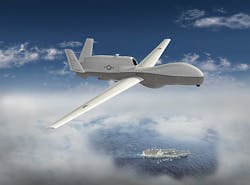MQ-4C UAV moves closer to operating safely in civil airspace with sense-and-avoid capability
Officials of the U.S. Naval Air Systems Command at Patuxent River Naval Air Station, Md., announced a $9.6 million contract Monday to the Northrop Grumman Aerospace Systems segment in San Diego for test and flight-control software updates for the Triton UAV.
The MQ-4C Triton is a version of the Northrop Grumman RQ-4 Global Hawk long-range and long-endurance UAV. The Triton is designed for long-range maritime patrol to assist the Navy's P-8A Poseidon manned aircraft with ocean patrol and anti-submarine warfare (ASW) missions.
This job also calls for Northrop Grumman experts to study how to install sense-and avoid, as well as anti-collision capability in the Triton's flight computer.
The goal is to find ways of installing the Automatic Response Module in the Triton's flight computer, which would provide sense-and-avoid capability based on the Airborne Collision Avoidance System For Unmanned Aircraft (ACAS Xu) architecture of the U.S. Federal Aviation Administration (FAA).
Northrop Grumman experts will evaluate the performance of ACAS Xu collision avoidance algorithms against air traffic using legacy Traffic Collision Avoidance System (TCAS II) messages and proof of concept Automatic Dependent Surveillance-Broadcast (ADS-B) messages.
ACAS Xu is the first collision-avoidance function designed specifically for UAVs. It can be matched to aircraft performance and is designed to operate together with future ACAS X variants as well as with legacy systems such as the TCAS II installed on most of today's commercial transport aircraft.
On this order Northrop Grumman will do the work in Rancho Bernardo, Calif., and should be finished by December 2017. For more information contact Northrop Grumman Aerospace Systems online at www.northropgrumman.com, or Naval Air Systems Command at www.navair.navy.mil.
Learn more: search the Aerospace & Defense Buyer's Guide for companies, new products, press releases, and videos
